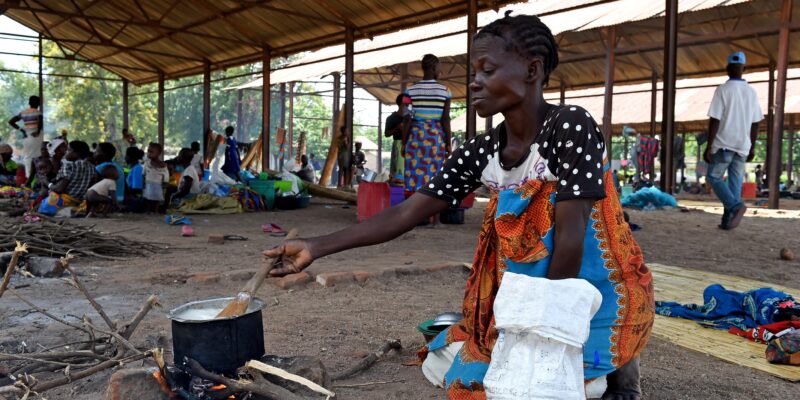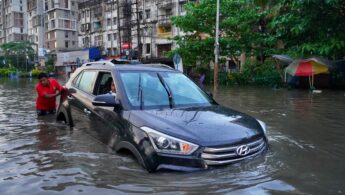Australia, a global climate outlier?
A growing number of countries include climate change and emissions considerations in their environmental frameworks. Australia does not.

At COP27 last year in Egypt, a milestone achievement was reached with an agreement to establish a new loss and damage fund. The fund is aimed at assisting “developing countries that are particularly vulnerable to the adverse effects of climate change”. A committee of developed and developing countries has begun work on the fund, and key details will be discussed during COP28 later this year in the United Arab Emirates. In their last meeting in early November, the committee agreed on a draft proposal for consideration at COP28, that would see the fund housed under the World Bank, with only voluntary contributions.
The debate on what is considered loss and damage, as well as who should compensate for it and how, has been ongoing for decades. While high-income countries are responsible for the majority of carbon dioxide emissions, they have been reluctant to commit to loss and damage funding due to concerns around legal liability.
Loss and damage refers to the inevitable impacts of climate change experienced by the Global South that have not been avoided through mitigation and adaptation due to socio-political or economic constraints, or that cannot be avoided because it is impossible to do so. It may include circumstances such as:
Some of these risks can be addressed through adaptation measures. If the measure is not yet available but could become available in the future, the risk is considered to be a soft adaptation limit. An example of this might be the development and implementation of an early warning system for floods in a region that is becoming increasingly flood prone. However, some risks have a hard adaptation limit, meaning the available technologies and actions for averting this risk are not feasible. An example is when an island becomes uninhabitable because of sea-level rise.
It is helpful to think about climate risks as being situated along a continuum of risks that have or will be avoided through mitigation, unavoided risks that cannot presently be avoided or reduced due to socio-economic constraints, and unavoidable risks with hard adaptation limits (see Figure 1).[1]Adapted from Finance for loss and damage: A comprehensive risk analytical approach. Loss and damage is centered around unavoided and, particularly, unavoidable risks.

Despite Africa being responsible for just 3% of all carbon dioxide emissions since the industrial revolution, it is the most vulnerable continent to the impacts of climate change. Nine of the 10 countries ranked as most vulnerable to climate disruptions are in Africa.
The loss and damage costs in Africa are estimated to range between USD 290 billion and USD 440 billion between 2020 and 2030, depending on the level of warming.
In 2022 alone, weather, climate and water-related hazards in Africa caused more than USD 8.5 billion in economic damages. More than 110 million people were affected by weather, climate and water-related hazards in Africa in 2022, and 5,000 deaths were recorded. However, the true toll is likely to be much higher due to underreporting.
Africa is already losing between 5% and 15% of its per capita economic growth due to climate change and related impacts, according to the African Development Bank.[2]Gross domestic product per capita measures a country’s economic output per person and is calculated by dividing the GDP of a country by its population. Studies estimate that African countries may face a 34% reduction in gross domestic product (GDP) per capita by 2050 on average even if warming is limited to 1.5°C.
The costs from climate change come in addition to the large amounts of funding African countries need for development and debt repayments. “The disasters triggered by the growing climate-related hazards threaten to undo decades of development gains and push millions back to poverty,” according to the United Nations Office for Disaster Risk Reduction.
Malawi is one of the poorest countries in the world, with over 50% of its population living below the national poverty line, and about 15% of its population experiencing acute food insecurity.[3]A national poverty line represents the cost of basic needs in a country, while an international poverty line represents the average national poverty line for the poorest 15 countries. The World Bank … Continue reading
The southeast African country has contributed less than 0.01% of cumulative global carbon dioxide emissions associated with human activities, but is extremely vulnerable to climate impacts. This is partly because Malawi’s economy is heavily reliant on the agriculture sector, which employs up to 80% of the population. Around 90% of people live in rural areas and are mostly reliant on rain-fed and smallholder farming, which is vulnerable to changes in rainfall patterns and extreme weather.
In March 2023, Tropical Cyclone Freddy broke records as the longest-lasting cyclone since weather records began, according to the World Meteorological Organization. Malawi received six months’ worth of rain in six days. The government of Malawi estimates that about 2.3 million people were affected, with 659,000 people displaced, 669 killed and over 500 people declared missing by mid-March 2023.
The housing and transport sectors suffered the worst damage, with more than 260,000 houses affected and damage to road networks limiting relief and recovery efforts. The agricultural sector was also significantly affected, with the loss of crops and expected reduction in output having serious impacts on peoples’ livelihoods and worsening food insecurity.
A post-disaster needs assessment estimated the total cost of damage at USD 507 million, while the total cost of recovery and reconstruction came to USD 680 million – equivalent to almost 6% of Malawi’s GDP. The amount of climate finance received by Malawi – estimated at USD 130 million in 2021 – does not come close to the amount of funding needed for the country to recover and rebuild.
The assessment also highlighted many non-economic impacts, such as the destruction of fragile ecosystems in the districts of Zomba, Chikwawa and Nsanje and damage to cultural heritage sites, including the Mbona Sacred Rain Shrines.
Cyclone Freddy is not a stand-alone event. Climate change induced extreme weather events in Malawi are becoming more frequent and causing losses and damages faster than the country is able to recover from them. Cyclone Freddy was the third extreme weather event to hit Malawi in just over a year, following Tropical Cyclone Ana and Gombe in 2022. The cyclones, as well as Cyclone Chedza in 2015 and Tropical Cyclone Idai in 2019, all led to significant loss of life, livelihoods and damage to infrastructure.[4]See here for additional case studies on the impacts of tropical cyclone Ana in Mozambique and Malawi.
The cumulative costs of damage and losses from these events came to well over USD 1 billion (Figure 2). When Cyclone Freddy hit, Malawi was still yet to recover from these disasters – alongside the lingering effects of the COVID-19 pandemic, Russia’s invasion of Ukraine, which disrupted supply chains and raised prices, and the deadliest outbreak of cholera in the country’s history.

The urgent need for emergency response and rehabilitation efforts in the aftermath of disasters can divert resources away from long-term recovery and development efforts. Frequent and consecutive disasters, like those experienced by Malawi, can deplete financial and natural resources. The government of Malawi said that climate-induced shocks are worsening macroeconomic instability and “making it harder for Malawi to break the cycle of vulnerability”.
The government estimates suggest the country loses an average of 1.7% of its GDP every year as a result of climate change-related disasters. Climate change impacts could result in annual GDP losses as high as 20% by 2040 if Malawi remains on its current low-growth development trajectory, and are likely to exacerbate existing social and economic inequalities, particularly for vulnerable groups. National data has shown that households in Malawi are 14% more likely to fall into poverty after a climate shock.
Analysis by ActionAid found that 93% of countries at the forefront of climate disasters “are drowning in debt”. When countries are hit with natural disasters and do not have the resources to respond and recover, they must borrow money. Finance is largely provided through loans, not grants, resulting in more debt. This often comes on top of existing loans that have to keep being paid back, which can push countries into a costly debt spiral. Borrowing money is expensive due to the perceived risk of lending to countries in crisis. The average cost of borrowing for the group of 58 climate-vulnerable nations is 10.5% – much higher than borrowing costs for developed countries, which is around 3.5%.
Currently, 38 out of the 63 most climate-vulnerable countries are spending so much on debt repayments that they are likely cutting spending on public services. Malawi is no exception – borrowing with high rates has “not only increased debt service costs but has also exacerbated vulnerabilities in public debt and pushed it to unsustainable levels”. Public debt in Malawi reached around 60% of GDP in 2022. Reserving a large part of the budget for debt servicing and disaster response threatens the allocation of funding for building climate resilience and slows progress towards development goals.
Key details for the loss and damage fund that still need to be resolved at COP28 include:
The key hurdle will be ensuring adequate levels of funds are available to deal with the scale of current and future loss and damage. Estimates of total global costs of loss and damage by 2050 range from USD 500 billion to USD 4 trillion, depending on the level of warming. In 2020, developed countries provided and mobilised a total of USD 83.3 billion in climate finance, with only a quarter of that going to African countries.
Developing countries have proposed that the fund should provide at least USD 100 billion by 2030 as a “minimum”. So far, seven United Nations member states as well as the government of Scotland and the Belgium region of Wallonia have pledged financing, amounting to around USD 294 million, with about 61% of that coming from Germany. Some of this funding comes from existing commitments.
Previous climate finance agreements, such as the 2009 goal to raise USD 100 billion in climate finance each year by 2020, have fallen short. It is critically important that the global loss and damage fund attracts adequate levels of funding to reinstill trust in international climate negotiations.
References
| ↑1 | Adapted from Finance for loss and damage: A comprehensive risk analytical approach. |
|---|---|
| ↑2 | Gross domestic product per capita measures a country’s economic output per person and is calculated by dividing the GDP of a country by its population. |
| ↑3 | A national poverty line represents the cost of basic needs in a country, while an international poverty line represents the average national poverty line for the poorest 15 countries. The World Bank estimates 72% of Malawi’s population live under the international poverty line of less than USD 2.15 a day. |
| ↑4 | See here for additional case studies on the impacts of tropical cyclone Ana in Mozambique and Malawi. |

A growing number of countries include climate change and emissions considerations in their environmental frameworks. Australia does not.

A dedicated loss and damage financing facility is high on the agenda for COP 27, but what exactly is loss…